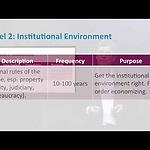In the next web lecture, Rolf Künneke will first explain the following definition of institutions: 'Institutions are systems of established and embedded social rules that structure social interactions' as introduced by Geoffrey M. Hodgson.
Using offshore wind energy as a running example, we will have a closer look at the institutional context in which a technology is being developed and implemented. For this institutional context, he will distinguish and explain the four layers indicated in the next figure. Responsible Innovation requires an adaptation in all levels of this institutional framework to be successful.

In the second web lecture, we will discuss in more detail the technical implications of offshore wind energy and the underlying values.
Readings for Four Layer Model of Institutions
Our suggested reading for this section is: "Institutional reform and technological practice: the case of electricity" by Rolf Künneke.
In this article, the 'Four Layer Model' introduced in the web lecture will be explained in more detail. The article also describes the interrelations between technological and institutional change from the perspective of re-structuring (liberalization) of the electricity sector. Liberalization means different rules, different players, different (more economic) values.
The article explains that - in order to make this liberalization a success - it might be necessary to stimulate certain technical developments. This aspect of technology regulation has not been very well acknowledged until now in the liberalization debate.
If there is a strong political desire to let liberalization succeed, regulation should stimulate certain technologies to enable the development of a technologically decentralized and fragmented electricity system. We are thinking micro-grids, smart meters and renewables.
